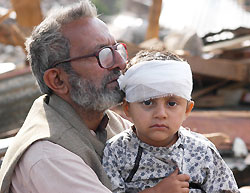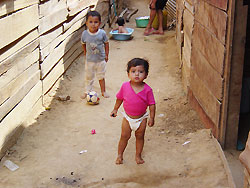The humanitarian world is changing rapidly. Disaster managers throughout Latin America and the Caribbean must be aware of new international mechanisms such as the cluster approach and what it will mean when the next disaster strikes
Coordinating external assistance following large-scale disasters is the responsibility of the government of an affected country. In an ideal world, the national disaster management authority (the Civil Protection system, the national emergency commission or some other institution) or a Ministry (Foreign Affairs or Health, for example) would be well prepared to take charge of major disasters that result in a massive influx of assistance from outside. But in the real world, are they in charge?
 In the last five years, Latin American and Caribbean countries have been spared the truly catastrophic disaster that moves the entire world to respond generously. But the overwhelming response to the tsunami in south Asia and the earthquake in Pakistan demonstrates how rapidly the humanitarian world is changing around us. Unfortunately, many national disaster coordinators in this Region may have scarcely noticed these changes, as they are so busy preparing for and responding to seasonal but traditionally moderate disasters.
In the last five years, Latin American and Caribbean countries have been spared the truly catastrophic disaster that moves the entire world to respond generously. But the overwhelming response to the tsunami in south Asia and the earthquake in Pakistan demonstrates how rapidly the humanitarian world is changing around us. Unfortunately, many national disaster coordinators in this Region may have scarcely noticed these changes, as they are so busy preparing for and responding to seasonal but traditionally moderate disasters.
Asia’s recent emergencies unleashed hundreds of jealously-independent external actors (UN, Red Cross societies, NGOs, bilateral agencies and foreign militaries). Consequently, coordination became extremely difficult and challenges, such as assessing needs, formulating priorities and minimizing gaps and duplications were poorly met. If the response to the Hurricane Mitch was regarded as somewhat chaotic, it was a model of coordination compared to the tsunami response.
The growing sense of solidarity with disaster victims—well orchestrated by both the media and humanitarian agencies—inevitably leads to not only generous contributions, but also to an uncoordinated rush of actors: an excess of field hospitals that arrive too late; psychosocial assistance groups with little experience; agencies tending to congregate around the most accessible sites and focusing on the most visible needs; and of course, the usual flood of unsolicited and inappropriate supplies. The litany of examples of mismanagement has been documented as far back as the milestone article by Alfred Sommer and Henry Mosley published in the Lancet, “The East Bengal Cyclone of November 1970: Epidemiological Approach to Disaster Assessment.” Some things still have not changed.
What has changed, however, is the perceived risk that the very process designed to strengthen the humanitarian community (“the world’s largest unregulated industry,” according to the Red Cross World Disasters Report 2004) could have the unintended consequence of marginalizing national institutions and by extension, the national disaster coordinators.
In the last two decades, the UN General Assembly has paid considerable attention to international mechanisms for ensuring a better coordinated response to emergency situations. Countries in and outside the Americas should be aware of the Inter-Agency Standing Committee (IASC), established in June 1992 in response to UN General Assembly Resolution 46/182 on strengthening humanitarian assistance. The IASC is a forum for coordination, policy development and decision making involving the key UN and non-UN humanitarian partners. One of the IASC’s important initiatives is the “Cluster Leadership Approach,” which is now being implemented.
The IASC has identified nine areas of humanitarian activity (logistics, emergency telecommunications, emergency shelter, health, nutrition, water/hygiene/sanitation, early recovery, protection and camp management) in need of strengthening. For each area, responsibility has been assigned to an IASC principal or full member. 1
 |
| PAHO/WHO coordinates the thematic group on health issues to the more than two million Colombian who are displaced. |
Accountability is what’s new
The cluster approach itself is not new. It is akin to the sectoral approach that PAHO/WHO and others have implemented for some time. In Colombia, for example, “thematic groups” are responsible for the coordination of issues related to the displacement of more than 2 million Colombians. PAHO/WHO coordinates the health thematic group. What is new, however, is the leadership concept and, more importantly, the formal operational accountability that the lead agencies must assume. Lead agencies are “accountable for ensuring, to the extent possible, the establishment of adequate coordination mechanisms… as well as adequate strategic planning and operational response.” Not only is the lead agency accountable for coordination of the cluster, it is also expected to be the provider of last resort when critical needs are not being met.
What is a provider of last resort?
As cluster leads, agencies work with relevant humanitarian actors that have expertise and capacity in a specific area. In a country facing an emergency situation or a disaster, the clusters provide support to the Humanitarian Coordinator. They do not necessarily carry out all of the activities themselves, but are responsible for ensuring that they are implemented. In this sense, if all else fails, the lead agency must step in to do the job itself. The concept of provider of last resort is the bottom line in accountability. However, the financial implications of this responsibility for cluster lead agencies require further examination and clarification.
Who are the cluster lead agencies?
Globally, the World Health Organization is the cluster lead for health, while UNICEF has been assigned the lead in nutrition and water/hygiene/sanitation. This is a departure from PAHO’s traditional practice of grouping these two areas together under the banner of health. However, the designation of cluster lead agency is an operational humanitarian responsibility that does not take away from WHO/PAHO’s normative and scientific leadership on all health matters, health being defined in the broadest sense.
Future impact on the Americas
What will the external response to the next major disaster look like to countries in Latin America and the Caribbean? Cluster approach or not, the marked tendency toward increased “internationalization” of disasters is unlikely to reverse itself. On the positive side, the international humanitarian community—donors, the UN and NGOs alike—feel directly accountable to the disaster-stricken population. However, imposing the cluster approach on a country without considering its level of sophistication and experience in disaster management may be perceived as arrogant. Worse yet, it may negatively impact local capacity building efforts, as pointed out in evaluation reports on the tsunami. It will be up to the countries of Latin America and the Caribbean to assess current changes in the global humanitarian sector and prepare themselves to assume a leadership role in response operations.
In the next issue of this Newsletter we will examine the factors that will influence the degree to which the cluster approach contributes to a more effective response and, in the process, ultimately strengthens national disaster management agencies.
1The IASC full members are the heads of the following agencies: UNDP, UNHCR, FAO, WHO, WFP, UNFPA and UNICEF.
